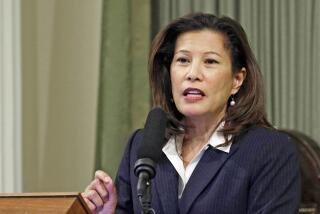Court’s First, Only Clerk, to Retire
- Share via
William W. Luddy, the only clerk the San Diego federal court has ever known, said Monday that he plans to retire at the end of the year.
Luddy, who has racked up 42 years of government service, 36 of them with the San Diego court, actually disclosed his retirement plans two weeks ago, first to the court’s judges, then in a tearful announcement to his 50 staffers. Neither he nor the court has made a formal announcement.
Luddy, 63, stressed that there was no controversy behind his decision. It just seems like time to move on, he said Monday.
“How many days do you have left?” he asked rhetorically. “I’m going to be 64 when I leave. I’d like to have a little bit of time left.”
Judge Judith N. Keep, the chief judge of the San Diego federal court, said Luddy had agreed to stay on through Dec. 31 to help pick a successor, to help implement a pilot program that calls on the court to streamline its system for processing civil lawsuits and to oversee the latest round of courtroom construction.
The court clerk’s primary job is to oversee the staff that maintain the court files. The clerk--each of the 94 federal trial courts in the nation has one--serves at the discretion of the court’s judges.
Luddy, Keep said, has “handled his job with such dignity.” The search for a replacement would be nationwide, she said.
Outside legal circles, the job of clerk of the court is a little-known post. It’s important enough at the courthouse, however, to pay $101,000 a year.
Luddy shepherded the San Diego court during a period of explosive growth. Beginning in the mid-1950s as a one-courtroom branch of the Los Angeles court, it now is its own separate district, with eight full-time judgeships, five magistrates and its own building, which seemingly always being built up and out.
“I’ve seen this office go from the old pen-and-eyeshade days to--probably by the end of this year--a place where you’ll have to look around for a typewriter, because everything is done by computer,” Luddy said.
When he began, Luddy said, there were no such things as federal magistrates, federal public defenders or rigid federal sentencing guidelines, all common now. The Miranda rule, which spells out an accused criminal’s rights to remain silent and to a lawyer, was years away.
A beginning clerk was paid $3,200 annually, Luddy said. The change “just almost boggles your mind,” he said.
Luddy grew up around Carson City, Nev. He served in the Navy from 1944 to 1948, then caught on with the federal court in Carson City for two years.
At that time, the federal court in Nevada was based in Carson City, Luddy said. Each May and November, the show went on the road to Las Vegas, to hear cases there. “Guess that gives you an idea of what was in Vegas then,” he said.
In 1951, Luddy began working with the post office in San Diego. He got a chance to go back to federal court work in November, 1954, at the clerk’s office in Los Angeles. The next May, he was assigned to the San Diego branch.
In 1956, he became courtroom deputy to Judge James M. Carter, who later would become the first chief judge of the San Diego court. In 1959, Luddy was named deputy in charge of the San Diego division.
In 1966, the branch court became its own court, serving San Diego and Imperial counties, and Luddy, Carter’s clerk, was appointed clerk of the court. The court now handles thousands of cases each year, most of them alien or drug-smuggling arrests from the U.S.-Mexico border.
Three years ago, Luddy and his wife of 42 years, Dorothy, bought their “dream house” near Rancho Penasquitos. They have five children and 14 grandchildren.
“If I had it to do all over, I’d do the same thing,” Luddy said.
More to Read
Sign up for Essential California
The most important California stories and recommendations in your inbox every morning.
You may occasionally receive promotional content from the Los Angeles Times.













